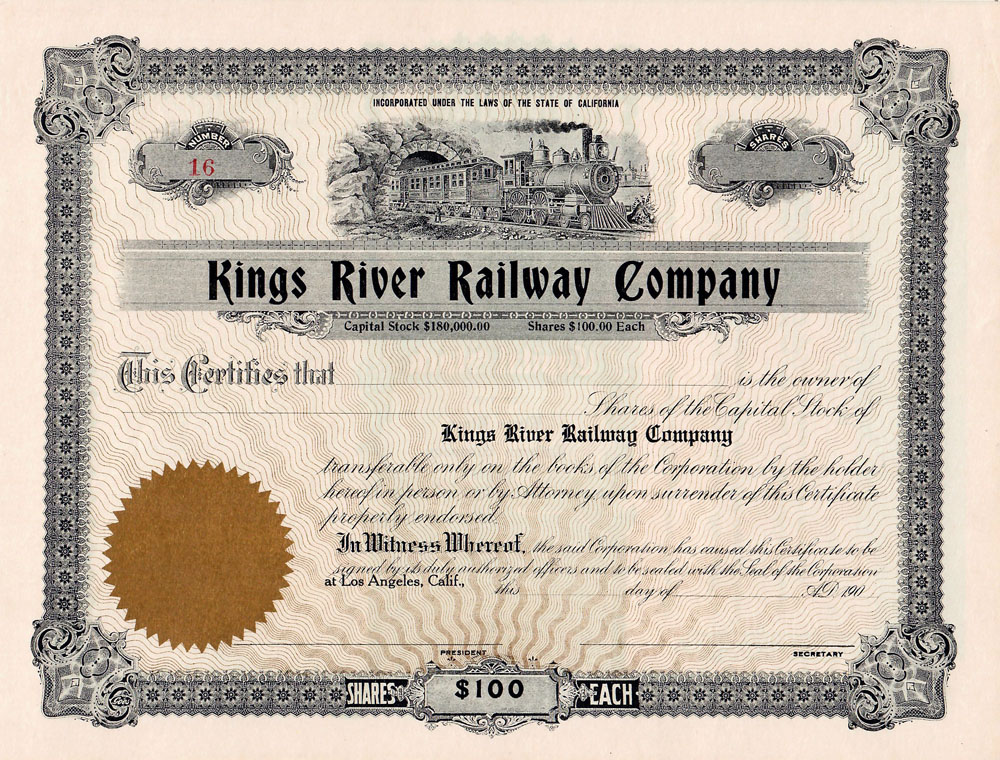Generic certificates
What are Generic certificates?
 Certificate printed by Goes Lithographing Co. Unknown secondary printer added company name, state, par value, capitalization and location of issuance (Los Angeles.)
Certificate printed by Goes Lithographing Co. Unknown secondary printer added company name, state, par value, capitalization and location of issuance (Los Angeles.)
I refer to generic certificates as stocks and bonds printed with standard designs and features that were used (or could have been used) for any number of companies. Oftentimes, these were standardized certificates that were sold by stationery dealers. Regardless of pre-printed designs, all of them feature lines or blank areas meant to be filled prior to formal issuance as securities. The vast majority were intended to be used as stock certificates and generally offer spots to record:
- company name
- stockholder name
- numerical numbers of shares
- verbal numbers of shares
- dates
- officer signatures
- par value
Most were pre-printed with the "Capital Stock" declaration. The majority of generic certificate printers also provided spots to record state of issuance and capitalization amount. Standard text normally stipulated that stocks were transferrable only on the books of the company. Much less commonly, textual mentions were made of shares being fully paid and non-assessable.
Most generic certificates were printed by lithographic methods and after 1910 by offset presses. In an effort to promote anti-counterfeiting measures, the New York Stock Exchange required companies to use engraved certificates after 1874. However, only small percentages of railroad companies were ever listed on the New York Stock Exchange or the Curb/American Stock Exchange. Small companies were either listed on smaller regional exchanges or not at all.
Startup and small companies were the primary users of generic certificates. Such documents were legal whether details were printed, typewritten, or handwritten. The majority of companies had secondary professional printers add their company names state of issuance and par values to generic stock certificates>
Mostly stock certificates
Almost all generic securities known are stock certificates. Very few generic bonds have appeared.
Identifying generic certificates
Unless certificates were printed by Goes Lithographing Company of Chicago, it is not always easy to identify what was a generic certificate and what might have been a custom design. In general, local printers lacked the capability to print corporate names in any alignment other than horizontal. If the name of the railroad company were printed horizontally, and especially if the name appears inside some sort of frame, the certificate is probably generic. If company names are printed in wavy or arched shapes, chances are good the certificate was a custom design.
Another general rule was the placement of printer names. It appears most printers who produced generic certificates placed their names below the bottom border. If they printed their names at all, secondary printers tended to place their names inside the bottom border. Beware of many exceptions.
The leader among companies that printed generic certificates
All sorts of printer names appear on what appear to be generic railroad stock certificates. While many of those printer names appear to represent primary printers, I suspect that the majority were actually secondary printers and the primary printers did not take credit.
The hands-down leader in printing generic certificates was and remains the Goes Lithographing Company, founded in 1879 by Charles B. Goes as a partnership named Goes & Quensel. The company printed letterheads, envelopes, invoices and checks for several years before printing its first certificate blanks in 1884. The company changed its name to Goes Lithographing Company in 1890 and printed everything with steam and hand-powered presses. The company began using offset lithography with zinc plates in 1906. Since then, it has weathered the Great Depression and computerization, but remains a prominent printer with a massive line of products, including generic stock certificates.

Goes' logo can be found on almost seventy percent of all generic certificates that are currently known to show a printer attribution. It appears a large number of additional certificates may have been printed by Goes without its familiar logo. Look in the bottom left corner of the borders of certificates for the oval-shaped logo shown here.
Goes' certificates are known with 37 different vignettes, the most common being the train exiting a tunnel as depicted on the stock certificate at top.
As of January, 2024, over 900 varieties of generic varieties of certificates in the railroad specialty can be attributed to Goes plus almost 500 more varieties in the coal mining specialty.
Just because Goes' certificates are generics and are highly repetitious doesn't mean it was not a major printer. American Bank Note Company is responsible for printing over nine times (!) more surviving varieties than the next nearest competitor in the railroad specialty. Second place is currently held by Goes.
Generic certificates were used much more heavily in the coal mining industry because operations were often small compared to most railroads. For that reason, Goes holds the lead for varieties currently identified in the coal mining specialty. American Bank Note Company is close behind.
|
Railroads |
Coal |
| Generic certificates as percent of all varieties |
6% |
24% |
| Goes certificates as percent of all varieties |
4% |
18% |
| Goes certificates as percent of all generics |
59% |
73% |
Most generic certificates are represented by only a single example. Even then, many of the printers were probably not the primary printers of the original generic designs. Based on surviving certificates, every printer after Goes is considered a very minor competitor in the generic stock certificate market.

The certificate at right is typical of many generic certificates. We don't know who printed the document and all details were filled in by typewriter.
Certificates like this rarely fetch high prices because, let's face it, they are plain. They are often not vignetted and they usually originated from a small company that never became famous. Nonetheless, some of these generic certificates are quite rare.